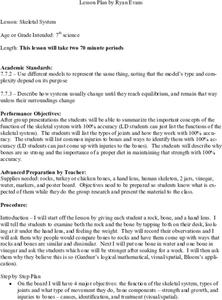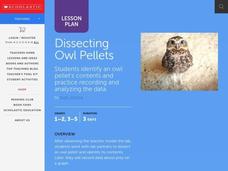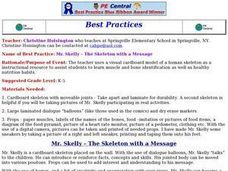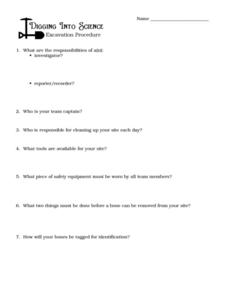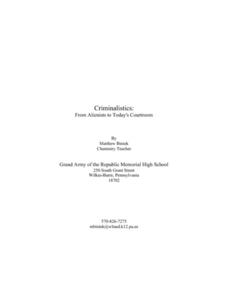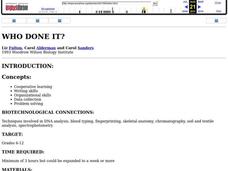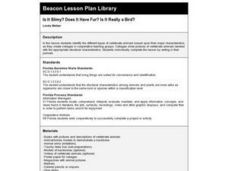Curated OER
How 'bout them bones!
After a lesson on the human skeleton, hand out a learning exercise that requires learners to identify the pelvis, rib cage, skill, spine, and thigh bones. They draw a line from the name of the bone to its location on the skeleton. Tip:...
Curated OER
Anatomy of a Bone - Coloring
Clarify and color code the anatomy of a bone with this resource. This worksheet lists 7 parts of a bone along with a definition for each part. Learners read through this information and color in each part of the bone a listed color. They...
Curated OER
Bones in Your Body
In this bone identification activity, students label each bone in the picture with the words provided in the word bank. Students then cut out each bone and fit them together to make a skeleton.
American Museum of Natural History
Identification Adventure
Put all the pieces together. After a skeleton is put together, pupils play the scientist to determine the type of animal they have by using a classification tree to narrow down the identity. After each decision, they gain advice from an...
Curated OER
Skeletal System
Seventh graders explore the functions of the skeletal system. They collaborate in small groups to determine the function of the skeletal system, the types of joints and movement, bone strength and growth, and bone injuries including...
Curated OER
Animal Signs
Students discuss the many different types of animal signs that can be used to identify and track animals. They participate in an hands-on activity in which they examine tracks, trails, homes, territory markings, and even "scat" left by...
Curated OER
Bones and Muscles
Third graders are introduced to bones as the body's means of support and protection. They research bone facts and conduct an experiment with chicken bones. They identify and observe involuntary muscles at work.
Curated OER
Dissecting Owl Pellets
Students examine owl pellets and what their diet consisted of, specifically rodents. This furthers their understanding of simple food chains as well as bone structure and identification.
Curated OER
Who Done It?
Pick and choose which activities to include in this crime scene investigation. Junior detectives can examine fingerprints, DNA, blood samples, or bone structure. The plan suggests you have teams solve a mystery, but it does not...
Curated OER
Dissecting Owl Pellets
Students watch the teacher model the dissection then in pairs, they dissect an owl pellet and identify its contents. They record the data about its prey on a graph.
Curated OER
The Skeletal System
Students identify bones off a skeleton during quizzes; assemble disarticulated skeletons; bird, frog and rat. They dissect frogs, remove the muscle tissue, and identify of bones.
Curated OER
Human Skeletal System
Students trace the outline of one of their members and draw in the bones from the diagram. They make flashcards of the bones out of index cards. Once the drawings and flashcards are finished, they quiz each other in preparation for a game.
Curated OER
Health: The Skeleton with a Message
Students identify human muscles and bones from a cardboard skeleton, named "Mr. Skelly." Using dialog balloons as props, the teacher holds up advice from Mr. Skelly, such as noting he drinks milk to keep his bones strong. The lesson...
Curated OER
Digging Into Science: Excavation Procedure
In this excavation procedure instructional activity, students determine the roles of group members for an excavation of a sample box containing buried bones. They complete 9 short answer questions before beginning the excavation.
Curated OER
Science: Criminalistics - A New Look at Crime
Students examine the world of forensic science, focusing on fingerprint analysis. In the lesson plan, they implement a method by which fingerprints of class members are categorized and identified. Elementary students study...
Curated OER
Sand & Water: Shape Search
Students act as amateur archaeologists as they participate in their own "dig" to explore and record unusual shapes. In this shape exploration lesson, students use trowels and shovels to dig, and learn to sift the dirt with screens to...
Curated OER
Owl Pellets
Students discover the contents of an owl pellet. In this science lesson plan, students explore the eating habits of owls and compare the contents of an owl pellet to the human skeletal system.
Curated OER
Who Done It?
Young scholars work in groups to solve various murder mysteries using DNA evidence to implicate suspects. Teams compete to solve the crimes the fastest, while using various scientific methods to accomplish their task.
Curated OER
Is It Slimy? Does It Have Fur? Is It Really a Bird?
Sixth graders identify the different types of vertebrate animals based upon their major characteristics, as they create collages in groups. Collages show pictures of vertebrate animals labeled with the appropriate structural...
Curated OER
Birds of Wisconsin
First graders explore the job done by ornithologists. They role play identifying the characteristics that make a bird a bird. They discuss what makes each bird species unique. Students are introduced to Wisconsin's most common and rare...
Curated OER
Make Sense of Nature
Students participate in this program that heightens their awareness and curiosity of nature as well as their sense of adventure and exploring new surroundings. They identify and choose an object from nature after exploring it with other...
Curated OER
The effects of microgravity
Fourth graders are given a scenario in the lesson that presents a problem that needs to be solved. They conduct research from multiple sources in order to gather information. This is used to contribute to possible solutions proposed by...
Other
Mananatomy.com: Classification of Bones
Four different types of human bone classifications are discussed through text and pictures. Shape, development, region, and structure classifications are further divided into the variety of bones each entails.
OpenStax
Open Stax: Bone Classification
This site helps you understand how the 206 bones that compose the adult skeleton are divided into five categories based on their shapes.




